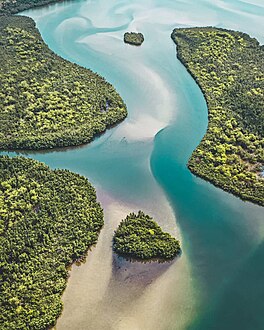Lake Piso
| Lake Piso | |
|---|---|
 | |
| Location | Grand Cape Mount County |
| Coordinates | 6°44′7″N 11°15′4″W / 6.73528°N 11.25111°W |
| Primary inflows | various rivers |
| Primary outflows | inlet to the Atlantic Ocean |
| Basin countries | Liberia |
| Max. length | 19 mi (31 km)[1] |
| Max. width | 10 mi (16 km)[1] |
| Surface area | 103 km2 (40 sq mi) |
| Islands | several (Massatin Island) |
| Designated | 2 July 2003 |
| Reference no. | 1306[2] |

Lake Piso, also known as Lake Pisu[3] and Fisherman's Lake,[4][5] is an oblong[6] tidal lagoon[1][7] in Grand Cape Mount County in western Liberia, near the town of Robertsport. Its name originates from a local term meaning "pigeon's hole" – a reference to the flocks of pigeons that once came to Lake Piso for water.[6]
Geography
The lake has an area of 103 km2 (40 sq mi).[6] It is the largest lake in Liberia.[7][8]
Hydrology
The brackish lake borders the Cape Mount peninsula. It is connected to the Atlantic Ocean by a narrow inlet[3] known locally as the "bar mouth".[9] Various rivers, including Mole Creek and Mafa River, empty into the lake.[3][7]
Environment
There are a number of islands in the lake, including Massatin Island, which are havens for monkeys and birds. The lake has been designated an Important Bird Area (IBA) by BirdLife International because it supports significant populations of many bird species.[10]
History
During World War II, Lake Piso functioned as a military base for Allied seaplanes.[1][5] It also served as temporary refuge for some Liberians during the Liberian Civil War.[6]
Lake Piso overflowed its banks at least twice in 1998, causing heavy flooding in Garwular District. Flooding in August 1998 occurred due to a blockage of the narrow inlet connecting the lake to the Atlantic Ocean, damaging some homes.[11] Additional flooding in September and October, brought about by heavy rains, affected over twenty settlements, causing at least ten deaths, leaving thousands homeless, and forcing others to leave their homes.[12][13][14][15][16] The floods led the government of Liberia to declare the area a "disaster zone".[17]
On December 13–14, 2002, the Papa Friends 2000 capsized in Lake Piso, at the confluence of the lake and Mafa River. The overcrowded wooden ferry was transporting approximately 200 passengers, most returning from the funeral of a local footballer. Only 15 people were rescued; the rest drowned and were recovered or presumed dead.[18][19][20][21][22]
A nature reserve was designated near Lake Piso in 1999[23] and, as of 2004, the Lake Piso wetlands, covering an area of 76,091 ha (761 km2), were Liberia's only designated wetland of international importance.[24]
Human activity
The area near the lagoon is the homeland of the Vai people.[9]
Human activity in Lake Piso includes fishing and water sports such as swimming, canoeing and water skiing.[8] Prior to the outbreak of the First Liberian Civil War, the lagoon was a popular travel destination for tourists.[25]
High-quality diamonds have been mined from the rivers that discharge into Lake Piso where "igneous intrusions provide potentially rich structural traps".[26]
Notes
- ^ a b c d Fox, Butterflies of Liberia, p. 26.
- ^ "Lake Piso". Ramsar Sites Information Service. Retrieved 25 April 2018.
- ^ a b c Walters, Guanya Pau, p. 79.
- ^ Cole, The Liberian Yearbook, p. 192.
- ^ a b Nelson, Liberia, a Country Study, p. 47.
- ^ a b c d Streissguth, Liberia in Pictures, p. 10.
- ^ a b c Hughes et al., Directory of African Wetlands, p. 387.
- ^ a b Streissguth, Liberia in Pictures, p. 72.
- ^ a b Walters, Guanya Pau, p. 39.
- ^ "Lake Piso (Cape Mount)". BirdLife Data Zone. BirdLife International. 2024. Retrieved 2024-11-08.
- ^ "Liberian Daily News Bulletin". Star Radio (Monrovia). 1998-08-22.
- ^ "Flooding in Liberia". BBC News. 1998-10-01. Retrieved 2008-03-10.
- ^ "Liberian Daily News Bulletin". Star Radio (Monrovia). 1998-09-17.
- ^ "Liberian Daily News Bulletin". Star Radio (Monrovia). 1998-10-09.
- ^ "Liberian Daily News Bulletin". Star Radio (Monrovia). 1998-10-10.
- ^ "Liberian Daily News Bulletin". Star Radio (Monrovia). 1998-10-11.
- ^ "Liberian Daily News Bulletin". Star Radio (Monrovia). 1998-10-23.
- ^ "More than 100 feared dead in boat accident in Liberia". Xinhua News Agency. 2002-12-16.
- ^ Toweh, Alphonso (2002-12-17). "At least 60 dead as ferry overloaded with footballer's mourners capsizes". The Independent. p. 13.
- ^ "More Than 100 Feared Drowned ...in Cape Mount Disaster". Africa News. AllAfrica, Inc. 2002-12-17.
- ^ "More than 80 bodies found in ferry accident". The San Diego Union-Tribune. 2002-12-18. p. A-15.
- ^ "Ferry disaster death toll rising". The Ottawa Citizen. 2002-12-18. p. A14.
- ^ Outram, Africa South of the Sahara 2004, p. 613.
- ^ UNEP, Desk Study on the Environment in Liberia, p. 52.
- ^ "Boat tragedy in Liberia". ONASA News Agency. 2002-12-16.
- ^ Mano River Resources (1999-05-25). "Mano River Resources - Final Results". Regulatory News Service.
References
- Cole, Henry B. (ed) (1962). The Liberian Yearbook. Liberian Review.
{{cite book}}:|author=has generic name (help) - Fox, Richard Middleton (1965). The Butterflies of Liberia. American Entomological Society.
- Hughes, R.H., J.S. Hughes, and G. Bernacsek (1992). A Directory of African Wetlands. Gland, Switzerland: World Conservation Union. ISBN 2-88032-949-3.
{{cite book}}: CS1 maint: multiple names: authors list (link) - Nelson, Harold D. (ed) (1985). Liberia, a Country Study. United States Government Printing Office.
{{cite book}}:|author=has generic name (help) - Outram, Quentin (2003). "Liberia". Africa South of the Sahara 2004. Europa Publications. pp. 611–18. ISBN 978-1-85743-183-4.
- Streissguth, Thomas (2006). Liberia in Pictures. Visual Geography Series. Twenty-First Century Books. ISBN 978-0-8225-2465-6.
- United Nations Environment Programme (2004). Desk Study on the Environment in Liberia. United Nations Environment Programme. ISBN 978-92-807-2403-5.
- Walters, Joseph Jeffrey (2004). Guanya Pau. Gareth Griffiths and John Victor Singler (eds). Broadview Press. ISBN 978-1-55111-365-4.

